

Grammar


Tenses


Present

Present Simple

Present Continuous

Present Perfect

Present Perfect Continuous


Past

Past Continuous

Past Perfect

Past Perfect Continuous

Past Simple


Future

Future Simple

Future Continuous

Future Perfect

Future Perfect Continuous

Passive and Active


Parts Of Speech


Nouns

Countable and uncountable nouns

Verbal nouns

Singular and Plural nouns

Proper nouns

Nouns gender

Nouns definition

Concrete nouns

Abstract nouns

Common nouns

Collective nouns

Definition Of Nouns


Verbs

Stative and dynamic verbs

Finite and nonfinite verbs

To be verbs

Transitive and intransitive verbs

Auxiliary verbs

Modal verbs

Regular and irregular verbs

Action verbs


Adverbs

Relative adverbs

Interrogative adverbs

Adverbs of time

Adverbs of place

Adverbs of reason

Adverbs of quantity

Adverbs of manner

Adverbs of frequency

Adverbs of affirmation


Adjectives

Quantitative adjective

Proper adjective

Possessive adjective

Numeral adjective

Interrogative adjective

Distributive adjective

Descriptive adjective

Demonstrative adjective


Pronouns

Subject pronoun

Relative pronoun

Reflexive pronoun

Reciprocal pronoun

Possessive pronoun

Personal pronoun

Interrogative pronoun

Indefinite pronoun

Emphatic pronoun

Distributive pronoun

Demonstrative pronoun


Pre Position


Preposition by function

Time preposition

Reason preposition

Possession preposition

Place preposition

Phrases preposition

Origin preposition

Measure preposition

Direction preposition

Contrast preposition

Agent preposition


Preposition by construction

Simple preposition

Phrase preposition

Double preposition

Compound preposition


Conjunctions

Subordinating conjunction

Correlative conjunction

Coordinating conjunction

Conjunctive adverbs


Interjections

Express calling interjection


Grammar Rules

Preference

Requests and offers

wishes

Be used to

Some and any

Could have done

Describing people

Giving advices

Possession

Comparative and superlative

Giving Reason

Making Suggestions

Apologizing

Forming questions

Since and for

Directions

Obligation

Adverbials

invitation

Articles

Imaginary condition

Zero conditional

First conditional

Second conditional

Third conditional

Reported speech


Linguistics

Phonetics

Phonology


Semantics


Pragmatics

Linguistics fields

Syntax

Morphology

Semantics

pragmatics

History

Writing

Grammar

Phonetics and Phonology


Reading Comprehension

Elementary

Intermediate

Advanced
Japanese adjectival morphology
المؤلف:
RICHARD LARSON AND HIROKO YAMAKIDO
المصدر:
Adjectives and Adverbs: Syntax, Semantics, and Discourse
الجزء والصفحة:
p66-c3
2025-04-08
133
Japanese adjectival morphology
The Ezafe construction and the general approach to DP structure pursued here suggest many intriguing connections, of which we will sketch just one. The Indo-Iranian language Zazaki exhibits the Ezafe construction in a significantly more complex form than Modern Persian. Whereas Ezafe is invariant (up to phonological alternation) in Persian, in Zazaki the Ezafe element inflects according to the number (sg/pl) and the gender (masc/fem) of the modified noun. Furthermore, and more importantly for our purposes, Zazaki distinguishes between a descriptive Ezafe, which links a modified noun with an adjective, and a genitive Ezafe, which links a noun to another noun in the possessive relation. Table 1 gives the set of Zazaki Ezafe forms, drawn from Todd (1985).1 Examples are provided in (1–2) also from Todd (1985).
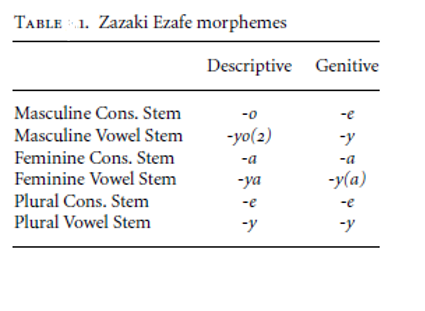
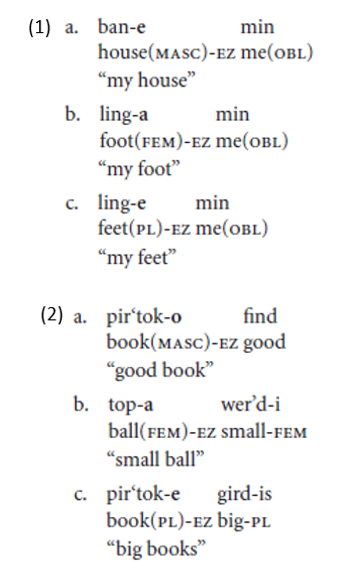
Under the view of Ezafe as a Case-marker, this suggests that Zazaki distinguishes at least two cases within the nominal: one with which it marks NP/DP modifiers in a genitive relation N (1), and a second that it uses for adjectival modifiers in a descriptive relation (2).
Given this result, it is interesting to observe that Japanese appears to make a very similar distinction in its system of marking for prenominal modifiers. Japanese contains a morpheme -no that is used to link a noun with an NP/DP in a genitive or modifying relation (3a–c).
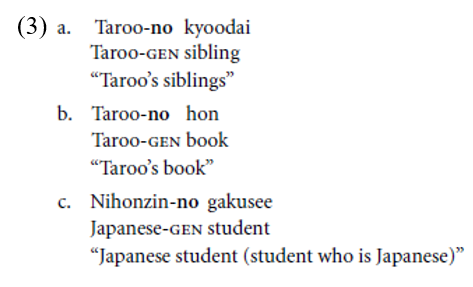
In addition, Japanese contains morphemes that are used to link a noun with an attributive AP, an AP in a descriptive/modifying relation. There are in fact two such morphemes, -i and -na, corresponding to the two classes of Japanese adjectives, so-called “true adjectives” (4a, b) and “nominal adjectives” (4c, d).
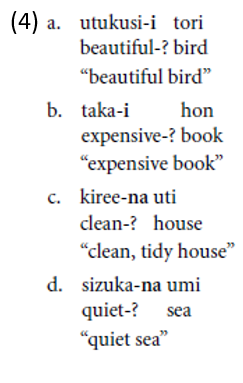
While the morpheme -no in (3) is standardly classified in Japanese grammar books as a genitive case-marker, the status of -i and -na has been much more controversial. A large number of linguists have assumed that these morphemes represent tenses, copulas, or tensed forms of the copula, implying that (4a–d) all represent covert relative clause constructions (5a–d).
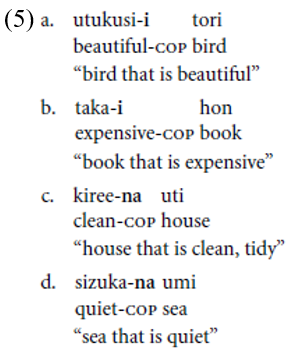
However, Yamakido (2000, 2005, 2007) argues convincingly that the relative clause analysis cannot be correct. One simple piece of evidence is the existence of non-predicating Japanese AP constructions like (6a, b).
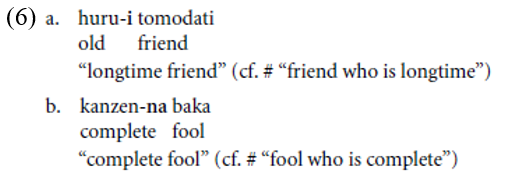
If the adjectival linking morphemes are not tenses, copulas, or tensed copulas, then what are they? Yamakido (2005) argues that these elements are in fact case morphology. Hence if she is correct, then not only do -no, -i, and -na form a set, their pattern (abstracting from number and gender) is essentially identical to that of Zazaki: -no represents the Japanese genitive Ezafe morpheme used to link a noun with a modifying NP/DP in a possessive relation, and -i/-na represents the Ezafe morpheme used to link a noun with a modifying AP in a descriptive relation.
1 Table 1 leaves out what Todd labels the subordinated Ezafe series, which occur in the context of certain oblique case environments. That Ezafe alternates in this circumstance again suggests that it is a form of case-marking. See Larson and Yamakido (2005) for more on subordinated Ezafe.